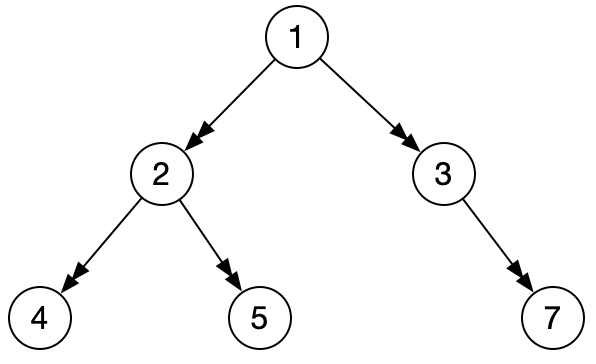算法练习(15)-设计1个二叉树的序列化与反序列化实现?
思路: 二叉树的各种顺序中,随便挑1种,遍历每个节点, 拼装出1个字符串即可实现序列化。要注意的是, 空节点也需要, 可以找一个特殊符号比如#表示。 反序列化则是相反的过程,解析该字符串即可。
这里用层序遍历来实现一把:
序列化代码:
public static String serial(TreeNode node) {
StringBuilder sb = new StringBuilder();
if (node == null) {
sb.append("#_");
return sb.toString();
}
Queue<TreeNode> queue = new LinkedList<>();
queue.add(node);
while (!queue.isEmpty()) {
TreeNode n = queue.poll();
sb.append(n == null ? "#_" : n.val + "_");
if (n != null) {
queue.add(n.left);
queue.add(n.right);
}
}
//注:0位置占位不用, 方便后面反序列化
return "*_" + sb.toString();
}
假设有一颗树:

把空节点补全后,如下图:

序列化后为 *_1_2_3_4_5_#_7_#_#_#_#_#_#_ 按"_"拆分成String[]后,就变成了二叉树的数组存储 , 如果根节点的下标从1算起,每个元素的左孩子索引为2*i,右孩子索引为2*i+1 ,它的父节点索引为i/2 (这也是为啥第0个元素要用*占位的原因),根据这个特性, 很容易可以写反序列化的代码:
public static TreeNode deSerial(String str) {
if (str == null || str.length() <= 0) {
return null;
}
String[] arr = str.split("_");
TreeNode root = new TreeNode(Integer.parseInt(arr[1]));
Map<Integer, TreeNode> parentMap = new HashMap<>();
parentMap.put(1, root);
int curr = 1;
while (curr < (arr.length >> 1)) {
int leftIndex = curr << 1;
int rightIndex = (curr << 1) + 1;
String leftVal = arr[leftIndex];
String rightVal = arr[rightIndex];
if (!"#".equals(leftVal)) {
TreeNode leftNode = new TreeNode(Integer.parseInt(leftVal));
int parentIndex = leftIndex >> 1;
parentMap.get(parentIndex).left = leftNode;
parentMap.put(leftIndex, leftNode);
}
if (!"#".equals(rightVal)) {
TreeNode rightNode = new TreeNode(Integer.parseInt(rightVal));
int parentIndex = rightIndex >> 1;
parentMap.get(parentIndex).right = rightNode;
parentMap.put(rightIndex, rightNode);
}
curr++;
}
return root;
}
当然, 也可以换成先序遍历实现, 序列化后为: 4_2_1_#_#_3_#_#_6_5_#_#_7_#_#_
/**
* 先序遍历序列化二叉树
*
* @param node
* @return
*/
public static String serial(TreeNode node) {
StringBuilder sb = new StringBuilder();
if (node == null) {
sb.append("#_");
return sb.toString();
}
sb.append(node.val + "_");
sb.append(serial(node.left));
sb.append(serial(node.right));
return sb.toString();
}
private static int curr = -1;
/**
* 先序遍历反序列化
*
* @param str
* @return
*/
public static TreeNode deSerial(String str) {
if (str == null) {
return null;
}
curr = -1;
String[] arr = str.split("_");
return process(arr);
}
/**
* 从左至右,每次取1个元素,按头-左-右的顺序构建
*
* @param arr
* @return
*/
private static TreeNode process(String[] arr) {
curr++;
if (!"#".equals(arr[curr])) {
TreeNode node = new TreeNode(Integer.parseInt(arr[curr]));
node.left = process(arr);
node.right = process(arr);
return node;
} else {
return null;
}
}
作者:菩提树下的杨过
出处:http://yjmyzz.cnblogs.com
本文版权归作者和博客园共有,欢迎转载,但未经作者同意必须保留此段声明,且在文章页面明显位置给出原文连接,否则保留追究法律责任的权利。
出处:http://yjmyzz.cnblogs.com
本文版权归作者和博客园共有,欢迎转载,但未经作者同意必须保留此段声明,且在文章页面明显位置给出原文连接,否则保留追究法律责任的权利。


